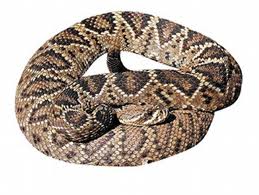One of the more mysterious animals in the Lowcountry is really pretty shy, long-lived, a homebody. And dreaded - the Eastern diamondback rattlesnake (Crotalus adamanteus). U.S. Forest Service biologists recently found diamondbacks in Francis Marion National Forest north of Charleston. They plan to attach transmitters, to learn what habitats the snakes are using and how they move and disperse. The snake is getting the close look because it's being considered as a federal threatened species. But the study joins a radio-tagging of 10 diamondbacks a few years back in the ACE Basin south of Charleston, as well as an ongoing 19-year study by South Carolina Department of Natural Resources herpetologists at the Webb Wildlife Center along the Savannah River. All three studies are aimed at figuring out how to get along with the reptile. Why in the world learn to live with a venomous animal that kills nearly half the people who are severely bitten?
Diamondbacks are in decline, and they are an alpha predator, a "flagship" species of the longleaf savannah. The savannah is healthy so long as they are around. And the longleaf habitat may be the most important Southeastern coastal forest habitat. It fosters 300 varieties of native plants, myriad birds including the wild turkey, 170 species of reptiles or amphibians and 36 mammals. With timbering and development, the longleaf's once vast spread across the coastal Southeast has shrunk to a tiny fraction of that acreage. Arborists are now in a multi-state effort to restore the longleaf.
"You take out one species from that ecosystem and you can alter the entire ecosystem," said Mark Danaher, forest service wildlife biologist who is part of the team conducting the Francis Marion snake study.
Source: The Item, 29 April 2014
http://www.theitem.com/news/ap_state_news/eastern-diamondback-rattlers-…

- Login om te reageren
